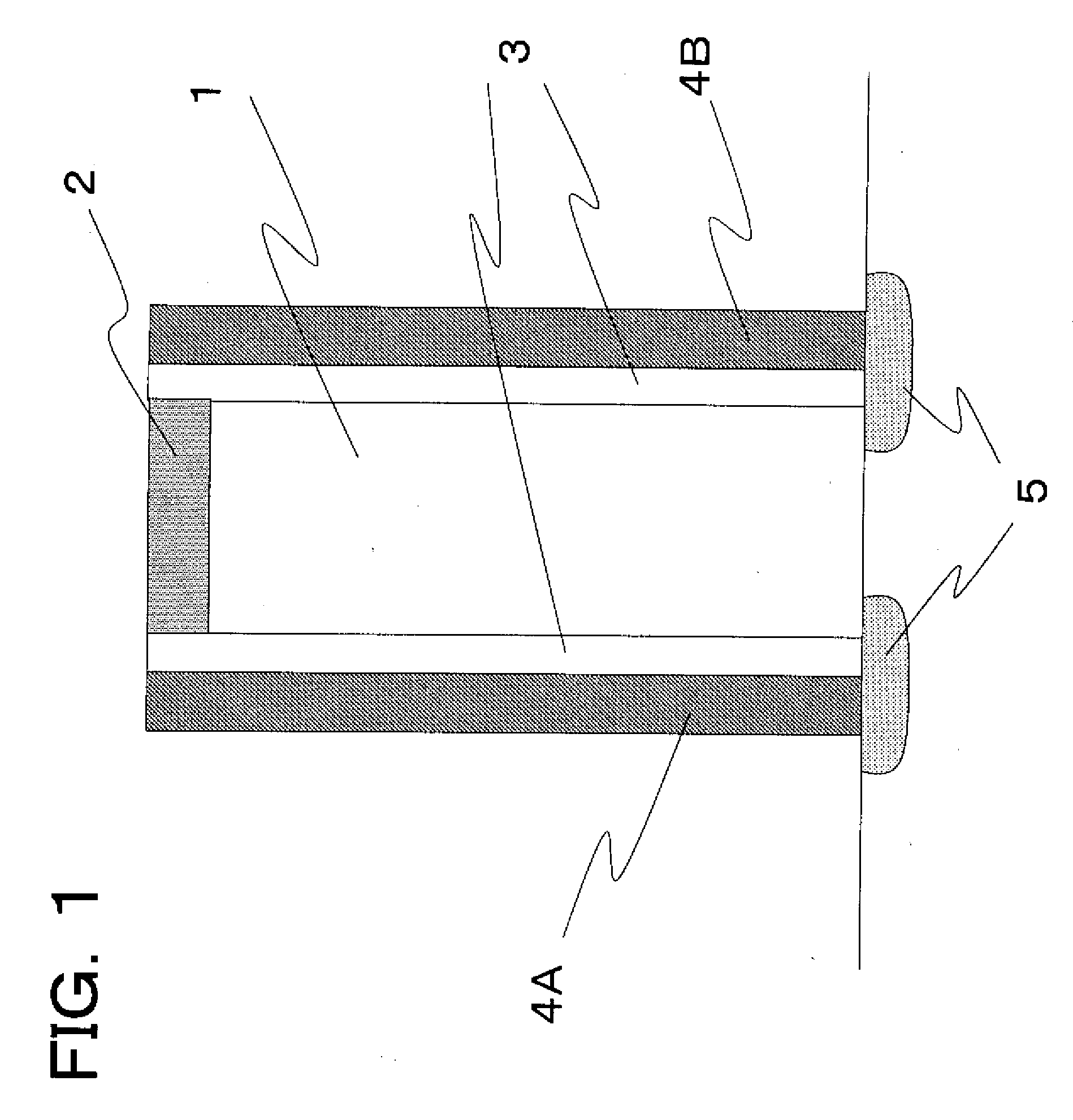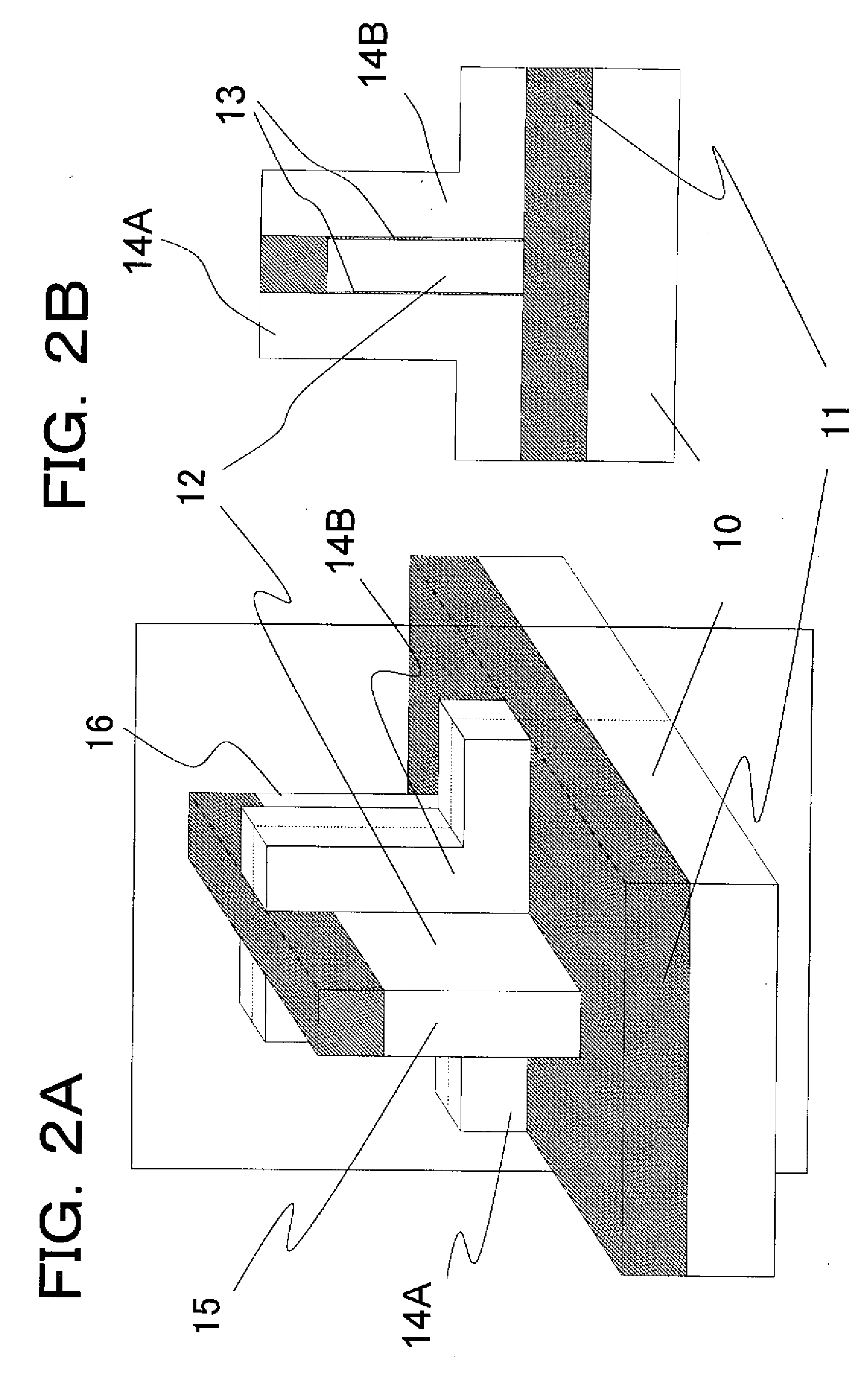Memory cell array, method of producing the same, and semiconductor memory device using the same
a memory cell array and memory cell technology, applied in the field of memory cell arrays, can solve the problems of difficult connection of electrodes located at the bottom of the 3-dimensional region of semiconductor to common interconnection lines such as bit lines or word lines, and the production process of memory cells each composed of one mosfet and one capacitor is complicated, and the production process is not good in compatibility with the logic circuit production process
- Summary
- Abstract
- Description
- Claims
- Application Information
AI Technical Summary
Benefits of technology
Problems solved by technology
Method used
Image
Examples
first embodiment
[0036] Referring to FIGS. 2 to 8, a memory cell array according to a first embodiment of the present invention is described below.
[0037]FIGS. 2A and 2B show a memory cell including one MOSFET (Metal Oxide Semiconductor Field Effect transistor) for use in a DRAM (Dynamic Random Access Memory) of the type called a 1T-DRAM. FIG. 2A is a perspective of the memory cell, and FIG. 2B is a cross-sectional view of the memory cell, taken along a plane shown in the perspective view of FIG. 2A. The memory cell shown in FIG. 2 is in accordance with the first embodiment of the invention. The memory cell shown in FIG. 2 is based on a memory cell using a fin-FET proposed in Japanese Patent Application No. 2004-141876 filed by the present applicant.
[0038] The fin-FET is a MOSFET formed in a 3-dimensional isolated region of a semiconductor formed on an SOI (Silicon On Insulator) substrate used as an insulating substrate. A source region is formed in a region including a first side surface of the 3-...
second embodiment
[0093] Referring to FIGS. 9 to 12, a memory cell array according to a second embodiment of the present invention is described below.
[0094] The memory cell array according to the second embodiment is composed of memory cells which are similar to those according to the first embodiment except that each back gate region, each source region, each front gate region, and each drain region are shaped by adjacent memory cells.
[0095]FIGS. 9A, 9B, 9C, 9D, and 9E show the memory cell array according to the second embodiment of the present invention.
[0096] In FIGS. 9A to 9E, reference numerals 70 denote SL lines, reference numeral 71 denotes a BG line, reference numerals 72 denote FG lines, reference numerals 73 denote BL lines, reference numerals 74 denote 3-dimensional isolated regions of silicon called fin regions in each of which a memory cell is formed, reference numeral 75 denotes a back gate region, reference numerals 76 denote front gate regions, reference numeral 77 denotes a contac...
third embodiment
[0132] Referring to FIG. 13, a memory cell array according to a third embodiment of the present invention is described below. The memory cell array according to the third embodiment is composed of memory cells which are similar to those according to the second embodiment except that fin regions in which memory cells are formed are connected in drain regions of memory cells adjacent in the row direction.
[0133]FIG. 13 shows a plan view of the memory cell array according to the third embodiment of the present invention. In FIG. 13, reference numerals 105 denote SL lines, reference numeral 106 denotes a BG line, reference numerals 107 denote FG lines, reference numerals 108 denote BL lines, reference numeral 109 denotes a 3-dimensional isolated region of silicon called a fin region in which a memory cell is formed, reference numeral 113 denotes a contact hole for contact with a corresponding back gate region of a memory cell (hereinafter such a contact hole will be referred to as a BG ...
PUM
 Login to View More
Login to View More Abstract
Description
Claims
Application Information
 Login to View More
Login to View More - R&D
- Intellectual Property
- Life Sciences
- Materials
- Tech Scout
- Unparalleled Data Quality
- Higher Quality Content
- 60% Fewer Hallucinations
Browse by: Latest US Patents, China's latest patents, Technical Efficacy Thesaurus, Application Domain, Technology Topic, Popular Technical Reports.
© 2025 PatSnap. All rights reserved.Legal|Privacy policy|Modern Slavery Act Transparency Statement|Sitemap|About US| Contact US: help@patsnap.com



